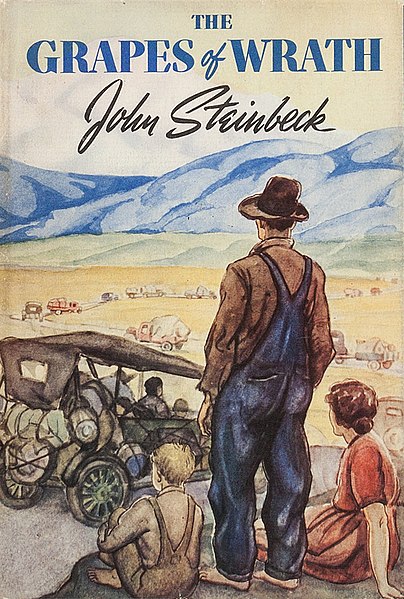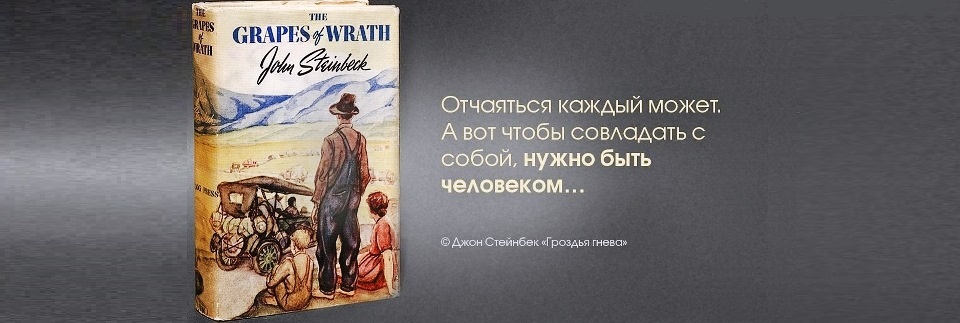«The Grapes of Wrath»
«The Grapes of Wrath» — Роман Джона Стейнбека, опубликованный в 1939 году. Удостоен Пулитцеровской премии в номинации «За художественную книгу». Входит во многие учебные программы школ и колледжей США. В 1940 году переведён на русский язык.
Источник
Анализ текста. Глава 17

The text under analysis is an extract from the widely-known novel “Grapes of Wrath” written in 1939 by John Steinbeck, an American writer. It was the book that ensured Steinbeck’s success as a realist author; in addition to being awarded the National Book Award and Pulitzer Prize for fiction, it was also given a special mention at the Nobel Prize ceremony in 1962. It should be mentioned that the book was the best-selling and highly discussed and debated book among critics, teachers and politicians – of the twentieth century American literature, — and still remains one of the nation’s and world’s best loved novels.
The action takes place on the way from Oklahoma to California. The main characters are the Joads family, tenant farmers in search of jobs, land, home and human attitude. Though the protagonist of the novel is Tom Joads, the second son of the Joads family, in fact, the story itself describes the typical fate of many men and many families in America in the 1930s. The historical background of the book is the 1930s, when many tenant farmers were forced out of work due to drought, economic difficulties, and changes in the agricultural industry. The background for their story, the atmosphere of constant search for their place in life, of hopelessness and fear, is constantly echoed by everyday scenes that explain the structure of this honest, rule-bound world of tenant farmers. So, two basic themes – hardships of migration and human relations – are combined in the book. The presented extract clearly describes both themes.
The extract for analysis represents the 3rd person narration; the author’s purpose was probably the interlacement of entertainment and aesthetic impact on the readers. This extract presents a detailed and thorough description of the living conditions and interpersonal relationships among farmers migrating to the West. The passage of the text does not have any external features; it is divided into paragraphs approximately equal in length, but having a tendency to decrease from the beginning to the end. From a detailed description of the life of migrants, the author finally comes to a clear and honed conclusion.
The stylistic devices used in the text by the author also serve to achieve this purpose — to clarify and involve the reader in all aspects of the life of migrating people, starting with the hardships and ending with the joys and confidence they gain when they are together – “the twenty families”, “a hundred people” joint by shared sorrow.
In the beginning of the extract the author depicts the general mood and state of the migrant people moving on their “way to the West”, divided and alone, desperate. He makes use of simile combined with repetition and alliteration in the sentence: “In the daylight they scuttled like bugs to the westward; and as the dark caught them, they clustered like bugs near to shelter and to water”. The verbs ‘scuttled’ and ‘clustered’ create the impression of crackling and rustling creatures, while the parallelism and repetition of the construction attracts the reader’s attention. Here for the first time the author introduces juxtaposition into the narrative. During the whole extract the opposition the daylight/morning/day and the dark/nighttime/night emphasize the difference between the actions, states and experiences of the characters at these times of the day.
To describe the initial states and the attitude to the place the people were moving to the writer applies such stylistic devices as simple epithets (‘lonely and perplexed’ about the people, ‘mysterious’ about the place of their future lives), metaphors accompanied by polysyndeton (‘a place of sadness and worry and defeat’ – about their previous home, ‘units of the camps, units of the evenings and the nights’ – about the people joint by a shared sorrow) and zeugma (‘shared their lives, their food, and the things they hoped for’). The above-mentioned example of zeugma is an excellent example that reveals the meaning of the extract as a whole. At night disunited migrants united and thus became one family. That is why in the text the author resorts to such metaphors regarding the people moving separately and united by an overnight stay – ‘the twenty families’, ‘a hundred people’.

The author also emphasizes the cyclical nature of migrant people’s actions that occur over and over again, using such syntactical and lexical expressive means as parallel constructions, lexical repetitions, enumerations, framing and polysyndeton. In the following example we can see anaphora (‘every night’) underlining the immutability and permanence of the traditions, enumeration of types of people (‘world complete with braggarts and with cowards, with quiet men, with humble men, with kindly men’) and a very picturesque simile — the world is compared with a circus:
“Every night a world created, complete with furniture, friends made and enemies established; a world complete with braggarts and with cowards, with quiet men, with humble men, with kindly men. Every night relationships that make a world, established; and every morning the world torn down like a circus”.
It should be noted that all types of relations are separated into all right and wrong, all types of human characters, all experiences in this world are clearly distinct, have their own names, are divided into “black and white” as if the world has returned to its beginning, was really just created.
The paragraphs in which the author describes the rights of those staying overnight in the camp are replete with lexical repetitions and graphic semicolons. It seems very important for the author to enumerate all the rights of these people who didn’t use to have such rights in their previous lives. And when it comes to the appearance of the rules and laws, he becomes distinct and even furious, moreover, he make use of alliteration, which is not typical of Steinbeck’s style: “It is unlawful to foul near the camp; it is unlawful in any way to foul the drinking water; it is unlawful to eat good rich food near one who is hungry…”.
In some cases, the narration resembles a church chant, full of prepositions detached constructions and parallelism, as in: “And with the laws, the punishments, and there were only two, a quick and murderous fight or ostracism; and ostracism was the worst. For if one broke the laws his name and face went with him, and he had no place in any world, no matter where created”.
John Steinbeck most often resorts to the use of syntactical stylistic devices, thus creating a kind of patchwork consisting of a set of traditions and rules and protecting migrants from the dangers of the outside world. As a metaphorical blanket that protects the guitar of the workers, and is unfolded only in an atmosphere of reliability and comfort, in the evening by the campfire.
To sum up, I’d like to say that the extract gives a good impression of the novel. It accurately conveys the atmosphere of disunity and the desire to unite people who share one grief in twenty families.